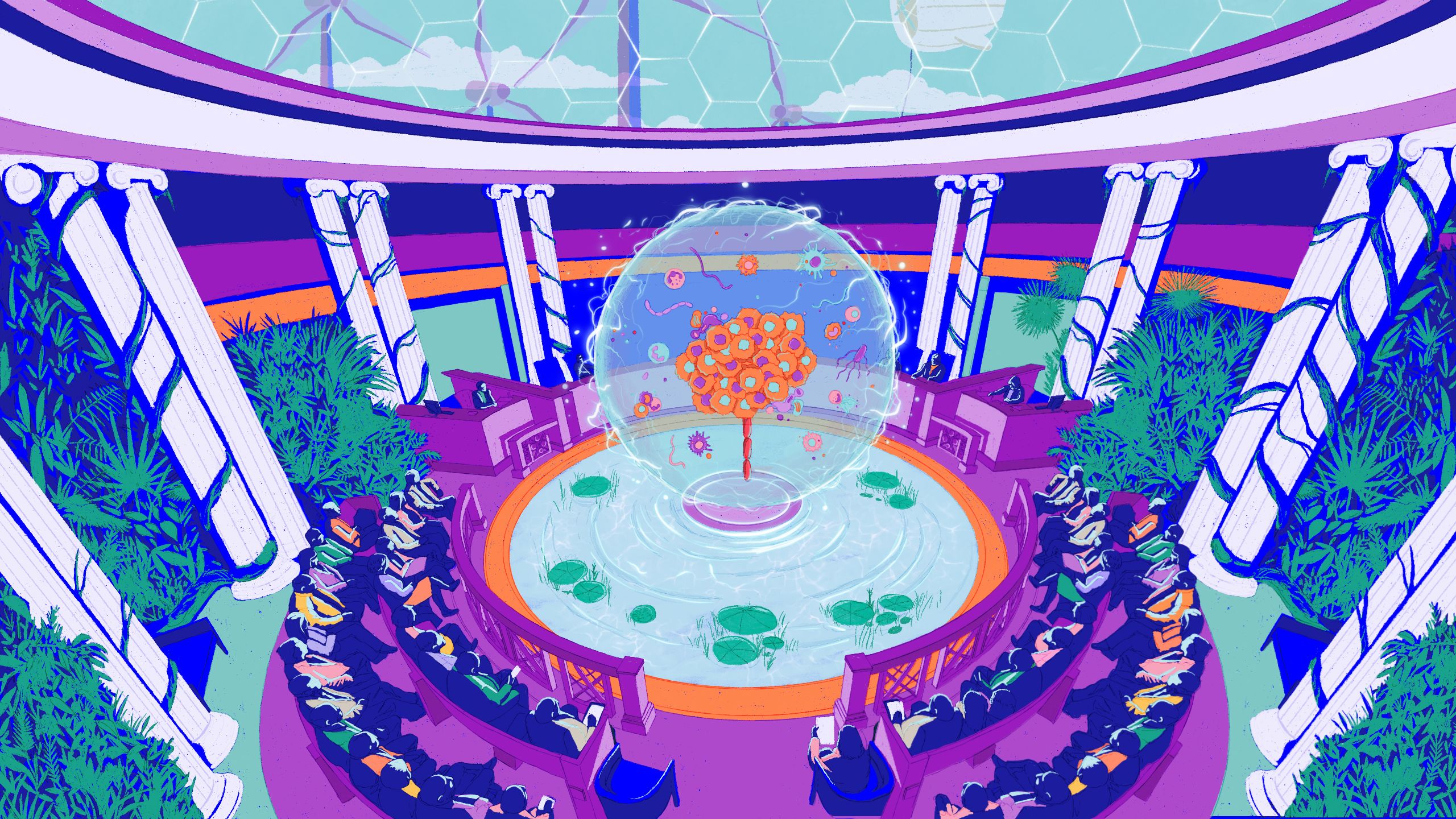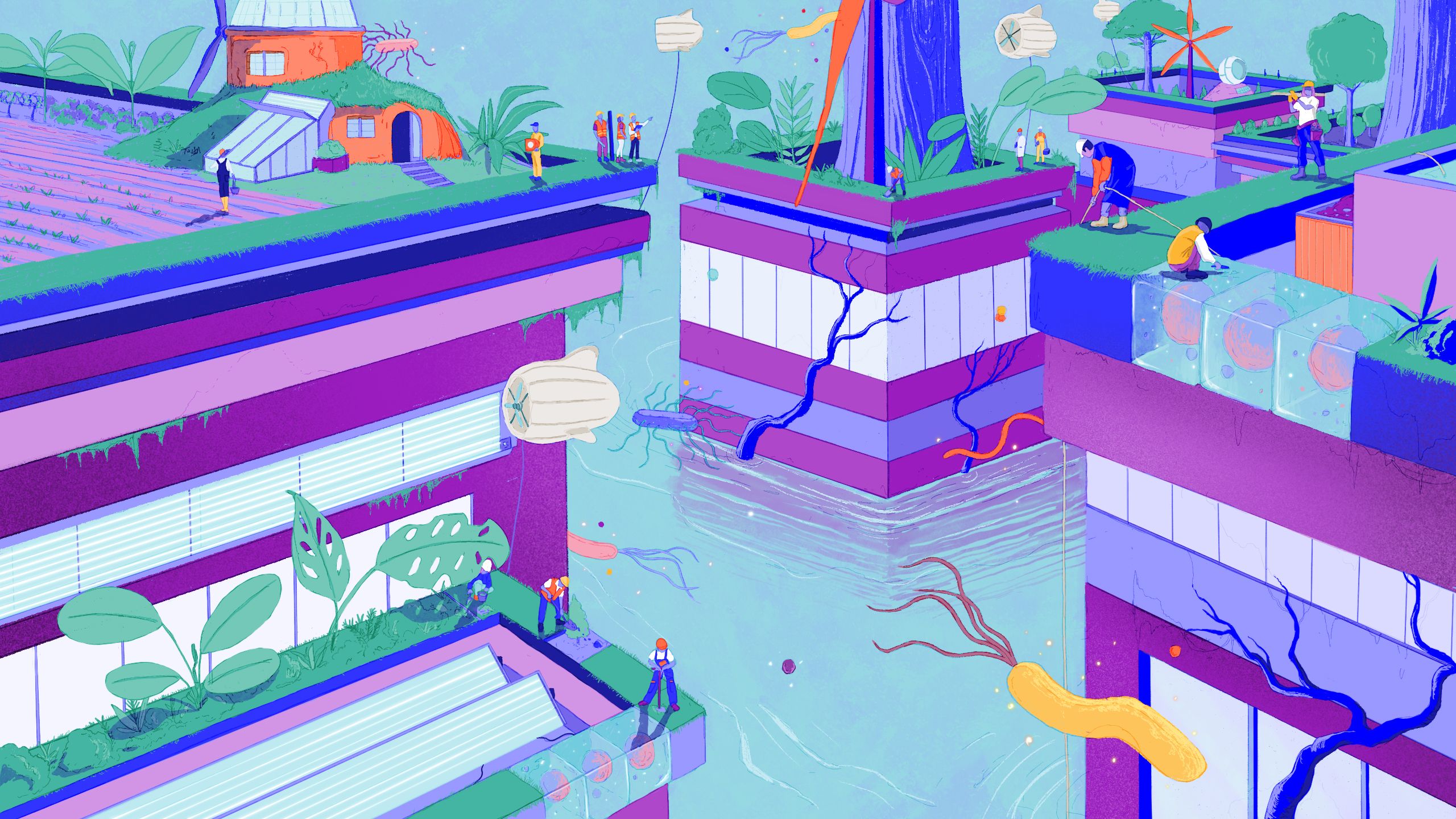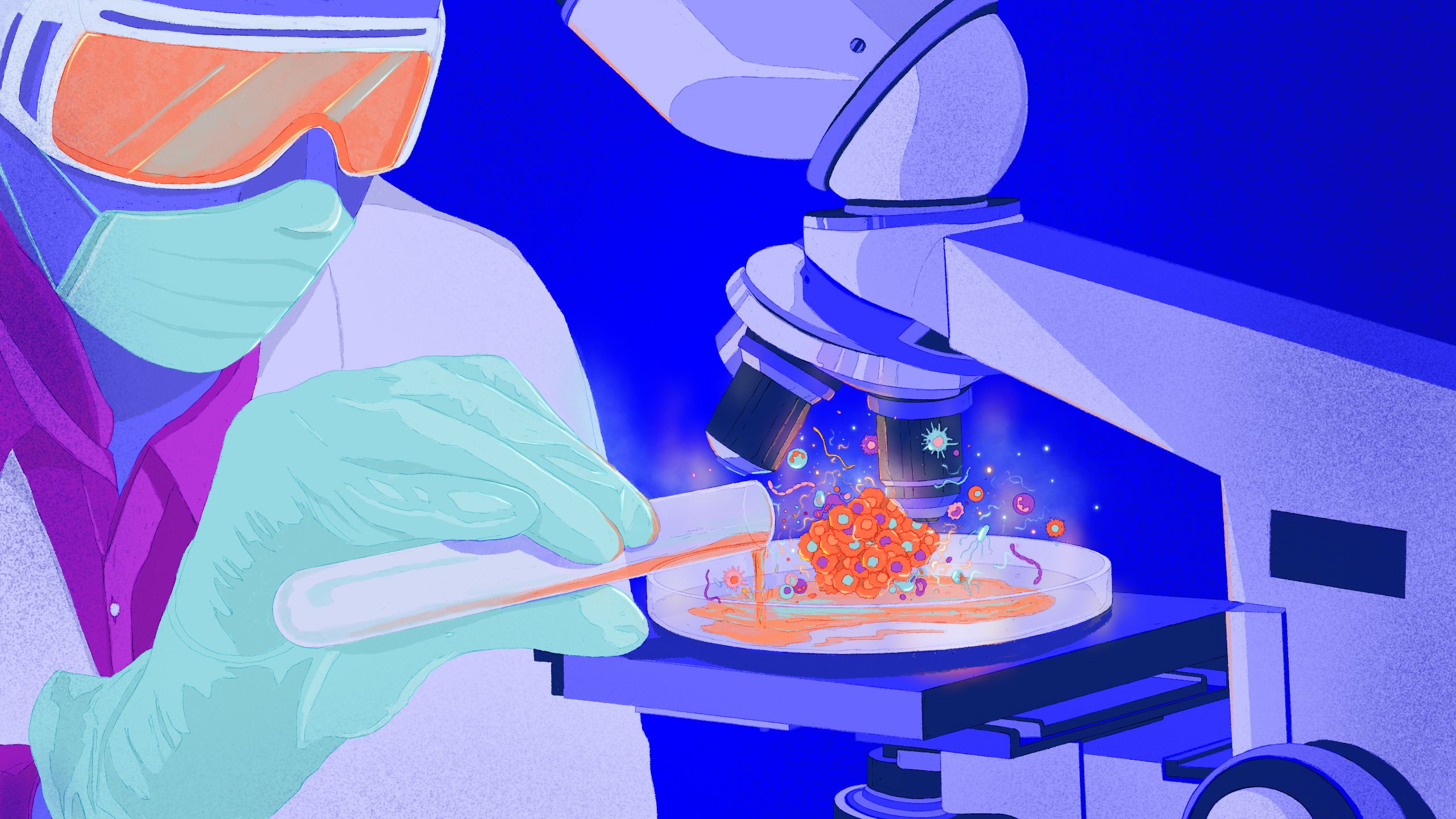Tech in the Dock: should synthetic biology be the next decade’s big bet to tackle climate change?
Nesta presents the evidence for and against betting on synthetic biology, a powerful emerging technology, to tackle the climate crisis.

Tech in the Dock puts an emerging technology on trial to examine its potential impact on society.
As a member of the jury, we welcome you to today’s case, which considers whether we should tackle climate change using synthetic biology.
The climate crisis continues to be one of the biggest challenges humans face. Synthetic or ‘engineered’ biology is one of the UK government’s priority technologies, having shown promise for improving human health, agriculture and manufacturing. Could we use synthetic biology to help nature to save itself?
The court will present the pros and cons to help you, the jury, reach a verdict. Can you decide, on the evidence available, if governments should bet on this technology?
What is synthetic biology?
Synthetic biologists use genetic engineering or modification (making new combinations of genes) and gene editing (where the contents of genes are changed) to create living organisms that can perform precise tasks.
Genes in living things naturally change and evolve by mutating and sharing genetic information between cells. “Bacteria trade genomic material like email,” says Daniel Drell, former biologist at the US Department of Energy. Traditional breeding methods capitalise on this natural mutation to develop plants and animals with specific features. Synthetic biologists enhance this process to make it faster, more precise and more useful.
Genetically modified organisms (GMOs) have courted controversy in previous decades as people were concerned about unintended effects on human health, society and the environment. Most controversial was the fact that GMOs typically combined genes from multiple species, creating organisms that could not exist naturally. Some think this crosses an ethical line, although parts of the world have extensively adopted the practice. Over time, attitudes to GMOs have softened. GMOs have become prominent in the global supply of many crops and there are regulations in place governing their safe use in many countries.
Several important breakthroughs this century have made synthetic biology much easier. Crucially, a tool called CRISPR-Cas9 enables scientists to ‘edit’ genes by cutting, adding or re-ordering them precisely.
A ‘DIY biology’ movement has been developing, which encourages non-professionals to learn about and try out genetic engineering techniques to encourage community-led scientific experimentation and engagement. Labs such as NYC’s GenSpace have paved the way for over 40 community labs worldwide, including in London, Manchester and Cambridge.
What is synthetic biology being used for?
Synthetic biology is already affecting our daily lives, even if this isn't always obvious.
Around the world, genetic engineering is used to make producing and storing food cheaper and easier, and to improve nutritional value and flavour. Synthetically produced vanilla flavouring, vegan meat substitute products like the ‘Impossible burger’ and even nutritionally enhanced tomatoes are all real-world examples of synthetic biology becoming widespread.
In fashion, synthetic biology-derived ‘vegan leather’ and non-plastic fake fur help to avoid concerns about animal rights and the environment.
And many people benefitted first-hand from cutting-edge gene-editing techniques in the development of the new mRNA vaccine technology that powered the quick delivery of COVID-19 vaccines.
Genetically engineered products are much less widespread in the UK. However, in 2023, the government scrapped regulations that effectively banned genetically edited plants and animals to allow the farming of ‘precision-bred’ organisms in England and Wales. This makes it possible to farm and commercialise species made using gene-editing techniques, as long as they result in an outcome that could have been achieved using traditional breeding techniques or natural processes. So the regulatory system for historically contentious GMOs still stands, but a new, lighter-touch regulatory system, designed to be proportionate to the risks of the application, will be available where applications meet the right criteria.
Moreover, the UK government recently listed ‘engineering biology’ (another way of saying synthetic biology) as one of its five priority technologies in the 2023 Science and Technology Framework. This suggests that, from the government’s point of view, the question is more ‘how’ we develop and use this technology, rather than ‘whether’ we should.
These applications all offer an engineered fix to a problem. As we face rising global temperatures, acidifying seas and declining biodiversity from climate change, what fixes could synthetic biology provide to tackle the climate crisis?

The case for using synthetic biology to tackle climate change
Some bold claims have been made about the possibilities that this new technology holds for tackling environmental issues. According to Charles DeLisi at Boston University, “The potential for impact is enormous. Without financial constraints, we could achieve a lot very quickly.”
Members of the jury, you will now be presented with a range of potential uses for and upsides of this technology.
Reducing emissions
Governments around the world have committed to collectively limit global warming to well-below two degrees celsius, and many make the case that we should be aiming for less than 1.5 degrees. To achieve this will mean cutting greenhouse gas emissions globally, and while there are less technologically complex ways to cut emissions, synthetic biology might be able to help.
- Industrial innovation: synthetic algae, bacteria and yeast could more efficiently produce biofuels to replace fossil fuels or make medicines and other chemicals while emitting less carbon dioxide than traditional methods.
- Greening goods: material scientists and biologists are collaborating to extend the lifespan of high-emission everyday materials, such as biological concrete that ‘self-repairs’ by reacting to water and filling cracks.
- Rethinking recycling: edited bacteria could help recover rare metals and minerals from recycled materials such as electronics, reducing the need to mine the earth’s limited supply of new metals, a process which is energy intensive, polluting and geopolitically contentious.
Climate repair and bioremediation
If we fail to reduce our emissions quickly enough to mitigate climate change, there might still be opportunities to repair the damage.
The removal of carbon from the atmosphere – sometimes known as carbon geoengineering – could be made easier and cheaper with synthetic biology, while making the most of nature’s own tools to fix the climate (this is not the same as capturing carbon as it’s emitted – there are around 35 carbon-capture and storage (CCS) projects in operation globally).
There are a few different geoengineering methods that scientists are looking at.
- Microbial methods: synthetic biologists can manipulate microorganisms to more effectively absorb carbon dioxide or help with ocean-based geoengineering to remove carbon dioxide from our acidifying seas. This indirectly reduces atmospheric absorption of carbon.
- Nimbler nature: the most reliable methods for carbon removal are ‘nature-based solutions’, relying on natural photosynthetic processes for CO2 absorption. Trees could be made to absorb more carbon dioxide by growing faster or bigger. As a carbon storage option, this only works if trees are put to long-term use rather than being burnt (which returns stored carbon to the atmosphere).
Climate scientists are also considering another type of geoengineering: solar radiation management. This doesn’t directly involve removing carbon but instead sees scientists manipulating the Earth’s surface or atmosphere to reflect the sun’s heat into space before it heats the Earth. It hasn’t yet been properly tested, with a few exceptions, but it could be improved by synthetic biology techniques.
- Reflective remit: we could develop more reflective plants and algae that bounce back more light and heat energy out of the atmosphere, cooling global temperatures.
There could be opportunities to reverse damage to the wider environment (indirectly helping to minimise climate change by rehabilitating ecosystems and preserving natural carbon absorption) by using genetic engineering to undo wider environmental damage.
- Purifying pollution: scientists are experimenting with game-changing novel organisms that break down pollution, such as mining-waste products, by identifying, ingesting and metabolising harmful substances to prevent water pollution.
Adaptation
Finally, however successful we are at reducing emissions, the world needs to be able to adapt to a changing climate. There could therefore still be a potential role for this technology in creating organisms that are more resilient and adapted to harsher climate conditions. This might not be ‘tackling’ climate change, but most climate experts agree that adaptation is a critical part of reducing harm.
- Fortifying food systems: biologists are testing genetic improvements to plants to make them more resilient under difficult conditions, which will help us continue to grow enough food to support the human population. For example, new edible crops with longer roots can reach further into the ground for moisture in drier climates and higher-yield crops require less energy and water.
- Bolstering biodiversity: conservationists are collaborating with synthetic biologists to help species threatened by extinction due to climate change. For example, gene-editing techniques can help us research the DNA that enables corals to survive warming oceans, which could help support the ecosystem of thousands of species whose existence depends on coral reefs.

The case against using synthetic biology to tackle climate change
You will now be presented with the evidence against, drawing on risks that critics have raised about both the technology itself and its prospects for tackling climate change.
Unknown environmental impacts
We can’t know the total impacts of releasing new, engineered species into natural ecosystems at scale, but it is possible that, once begun, we won’t be able to manage the spread and impact of these species. We now understand more about the release of GMOs and many scientists agree that GMOs are not dangerous to the environment simply because they are genetically modified, but little to no evidence exists for gene-edited crops, none of which have been grown at scale, and there’s also the risk that DIY biologists make mistakes. Some potential risks include a negative impact on biodiversity and reduced soil quality, although optimists would highlight that engineered species could also improve these two areas. However, both these environmental risks and more are already realised by existing monocultural farming approaches around the world.
Questionable ethics
Ethicists have examined the question of whether it is right for humans to create ‘unnatural’ organisms. Some consider it ethically or morally dubious for scientists to ‘play god’ by synthesising life, particularly in more speculative branches of synthetic biology such as xenobiology (creating entirely new or ‘alien’ life forms) or de-extinction. The GMO debate in the 1990s showed the strength of feeling around this ethical debate. Some people may have similar concerns about techniques being used today, although proponents argue that they do not cross the same ethical line if genetic changes could theoretically occur in nature, rather than being naturally impossible. Transparency and labelling in the development and sale of genetically engineered products also pose ethical issues, as there is no consistent regulation over labelling products which are synthetically produced, meaning consumers may not be aware of what they’re buying.
Complexity of global coordination
Action on climate change requires worldwide coordination due to the global nature of our climate systems, but the complexity and risk of some synthetic-biology-based approaches such as geoengineering is likely to mean negotiating an approach to using the tech will take a long time. International political coordination of far less controversial means of slowing climate change, such as emissions reduction, is criticised for being too slow. As well as international policy collaboration, we would need to see far more international scientific and interdisciplinary collaboration (with fields like social science), to maximise the potential and minimise the harms of this technology.
Lack of readiness
Although there’s been lots of progress, most experts agree that at current rates the technology is unlikely to be sufficiently developed, commercialised and scaled quickly enough to play a meaningful role in the time left to keep the planet under two degrees of global warming. So we could be timed out on relying on synthetic biology for mitigating climate change before it happens. However, experts are confident that synthetic biology could help to draw down atmospheric carbon in the longer term, which means that this technology might be useful to help lessen climate damage later in the century if changes are not irreversible. Using synthetic biology for adaptation or repair, rather than prevention, seems most plausible in terms of tech readiness aligning with the planet’s needs in time.
Who foots the bill and reaps the reward?
Although this is also a problem faced by many other emerging technologies, it’s not clear who should fund and lead the development of synthetic biology (either the fundamental science or its application to climate issues, because it could support progress in so many areas and benefit many different actors. This lack of direction means that currently the focus is on commercially viable applications rather than broader public good. Considerable economic disruption, with various winners and losers, could occur alongside a significant shift towards using synthetic biology for industrial processes or new products, for example by making more traditional industries obsolete. In addition, widespread adoption of the technology would give rise to political debates such as fair land use and who should benefit from the ability to patent nature (which is already playing out in discussions of the Nagoya Protocol).
What does a big bet look like?
If the jury decides to rule in favour of synthetic biology being the next big bet for tackling climate change, it’s still far from clear what this looks like.
Actions governments could take to support the development and application of this technology to help tackle climate change fall into a few categories:
- Supporting development of the fundamental science: this could range from continuing with or increasing funding for early-stage research to encouraging better popular understanding of the technology, for example delivered through information or educational campaigns.
- Providing an environment for profitable market-driven private investment: the regulatory regime can pose a major hurdle for companies looking to apply this tech, particularly raising entry barriers for smaller companies looking to innovate. Making this process fit for purpose is key: it should be simple and understandable while maintaining necessary checks and balances.
- Helping to guide application of the technology to address climate change: an implicit or explicit mission-focused approach to synthetic biology for the climate would use levers such as making innovation funding more targeted to applications and outcomes, greater public investment in larger-scale infrastructure or strategic use of governments’ buying power to support synthetic-biology-derived green products or services.
- Pushing for greater international dialogue and coordinated action: many issues require careful deliberation between international actors to make the most of the technological potential, requiring multinational agreement of actions, consistent regulation, effective negotiation of public-private partnerships, consideration of international legal frameworks and jurisdiction, and more.
But betting on this technology goes beyond the government. It would take various actors – scientists, businesses, financiers and of course ordinary people as consumers and voters.
So… should synthetic biology be the next ‘big bet’ for tackling climate change?




At this fork in the road, we see a few different pathways for synthetic biology as a climate change solution. Now that you’ve been presented with the potential benefits and risks of synthetically engineering biology to fix the climate crisis: what's your verdict?
Cut back
Reduce or stop government support for the application of synthetic biology to the climate crisis. Synthetic biology is too great a risk; the world should focus on building public and political support for mainstream methods for cutting emissions.
Spread our bets
Keep investing in exploring the technology to see where it goes, in balance with other methods of climate action. Synthetic biology won’t be ready in time to prevent climate change, but it could help with climate repair or adaptation in future.
The ‘big bet’
Throw more energy and resources into developing the technology and coordinating its use for climate action. We can get around the deliverability issues with investment. Other risks are worth it, given the scale of the crisis.
Read our verdict
Voting has now closed on this case and you can now read our verdict on synthetic biology for the climate.
Acknowledgements
We’re grateful to Andrew Firbank for his help in the early stages of this case. The following people acted as critical reviewers of this case but do not necessarily support or endorse the findings.
- Alexander James Phillips, digital and biotech research and consultant
- Alistair McCormick, University of Edinburgh
- Aristides Patrinos, PhD
- Bill Adams, Geneva Graduate Institute
- Charles DeLisi, Boston University
- Daniel W. Drell, US Department of Energy (retired)
- Frank Sargent, Newcastle University
- Izzy Webb, Department for Science, Innovation and Technology
- Jane Calvert, University of Edinburgh
- Jenny Molloy, University of Cambridge
- Joyce Tait, University of Edinburgh
- Kent H. Redford, Archipelago Consulting
- Louise Horsfall, University of Edinburgh
- Les Firbank, University of Leeds
- L.Val Giddings, Information Technology & Innovation Foundation
- Patrik Jones, Imperial College London
- R.J. Roberts, New England Biolabs
- Stephen Patrick Long, University of Illinois
Editor: Siobhan Chan
Illustrator: Simone Rotella